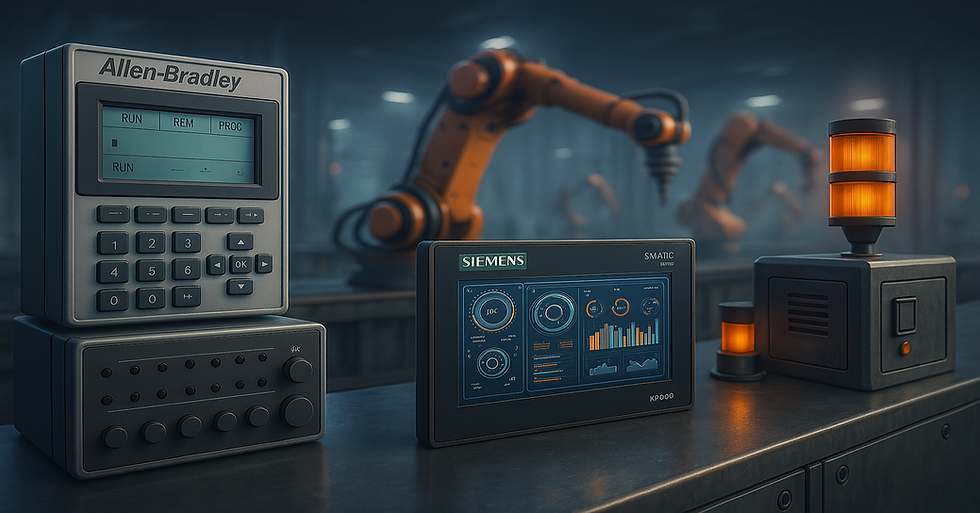How AI is Transforming Robotics and Controls Engineering
- Sandra Moros
- Mar 21
- 4 min read
Artificial Intelligence in Industrial Automation

Industrial automation is evolving at an unprecedented pace, and artificial intelligence (AI) is at the center of this transformation. From enhancing robotics programming to optimizing industrial workflows, AI is redefining what is possible in automation.
At Humber Automated Systems, we specialize in automation engineering solutions across industries such as automotive, energy, and pharma. As AI-driven technologies become more prevalent in industrial settings, companies that integrate these advancements into their robotics and controls engineering processes gain a competitive edge in efficiency, accuracy, and scalability.
AI’s role in automation extends beyond basic programming. It enables predictive decision-making, real-time adaptation, and autonomous learning within industrial systems. This article explores five AI tools that are shaping the future of robotics and controls engineering.
1. TensorFlow: AI-Powered Machine Learning for Robotics

Machine learning is one of the most significant AI applications in industrial robotics, and TensorFlow is among the most widely used frameworks for developing intelligent automation solutions. By analyzing large datasets, TensorFlow enhances robotic decision-making, allowing machines to identify patterns, detect anomalies, and optimize operations autonomously.
In industrial settings, TensorFlow is used for machine vision applications such as defect detection, predictive maintenance, and automated inspection systems. Manufacturers benefit from improved quality control and reduced downtime, leading to greater operational efficiency.
2. OpenAI Gym: AI-Driven Reinforcement Learning for Robotics

Traditional robotics programming relies on predefined rules and structured logic, but AI-powered reinforcement learning takes automation to the next level. OpenAI Gym provides a framework for developing and training intelligent robotic systems that can adapt, learn, and optimize their performance based on real-time feedback.
This AI-driven approach is particularly useful in robotics and controls engineering, where models trained in OpenAI Gym can improve:
Autonomous robotic movement – Enabling robotic arms and mobile robots to navigate complex environments.
Self-optimizing automation – Allowing robots to learn from their mistakes and enhance efficiency over time.
AI-driven predictive maintenance – Identifying potential system failures before they occur, reducing downtime and maintenance costs.
OpenAI Gym is widely used in industrial automation, logistics, and manufacturing to create AI-powered robotic control systems that continuously improve their performance.
3. NVIDIA Isaac Sim: Digital Twin Simulation for Robotics

Simulation technology is transforming how industrial automation systems are designed and optimized. NVIDIA Isaac Sim leverages AI-powered digital twin technology, allowing engineers to create virtual models of robotic systems that mirror real-world conditions.
By using AI-driven physics simulations, Isaac Sim enables engineers to:
Optimize robotic workflows before deployment.
Train AI models in a virtual environment, reducing hardware costs and risks.
Improve automation strategies by testing different AI-driven control logic.
This tool is particularly useful for automotive and manufacturing applications, where companies need to validate AI-powered robotic systems before integrating them into live production environments.
4. Google AutoML for Robotics: AI-Powered Vision & Automation

Developing AI models for robotic vision and automation can be complex, but Google AutoML simplifies the process. This AI-powered automation tool allows engineers to build and deploy machine learning models for robotics without extensive expertise in data science.
Google AutoML is transforming robotic perception and automation programming by enabling:
AI-enhanced vision systems for real-time defect detection.
Adaptive robotics programming that learns from new production environments.
Automated AI model training, accelerating the development of intelligent robotics applications.
By leveraging Google’s AI-powered AutoML tools, industrial automation companies can enhance robotics systems with real-time decision-making capabilities, improving efficiency and accuracy across various applications.
5. IBM Watson for Industrial AI: Predictive Maintenance & Automation Optimization

As AI becomes more integrated into industrial automation, predictive analytics and intelligent decision-making are becoming essential for maximizing robotic system efficiency. IBM Watson for Industrial AI enables companies to use AI-driven predictive maintenance and automation optimization to reduce downtime and improve production performance.
IBM Watson helps robotics and controls engineers by:
Analyzing sensor data in real-time to predict failures before they happen.
Optimizing automation processes using AI-powered insights.
Enhancing decision-making through AI-driven operational intelligence.
With AI-powered predictive maintenance and intelligent automation analytics, IBM Watson helps industrial automation companies create smarter, more reliable robotic systems that minimize disruptions and maximize efficiency.
The Future of AI in Robotics and Controls Engineering
AI is rapidly becoming an essential component of industrial automation, driving advancements in robotics programming, PLC optimization, and system integration. Companies that adopt AI-powered automation solutions are better positioned to improve productivity, reduce costs, and enhance operational flexibility.
At Humber Automated Systems, we remain committed to staying at the forefront of automation engineering by integrating the latest AI-driven technologies into our solutions. As AI continues to shape the future of robotics and controls engineering, businesses that embrace these innovations will gain a competitive advantage in an increasingly automated world.
📩 Want to learn more about AI-powered automation solutions? Contact Humber Automated Systems today.
References
Google TensorFlow. TensorFlow Machine Learning Framework
OpenAI. OpenAI Gym for Robotics
NVIDIA Isaac Sim. AI-Powered Digital Twin Simulation
Google Cloud. AutoML for Robotics
IBM Watson. Industrial AI & Predictive Maintenance





header.all-comments